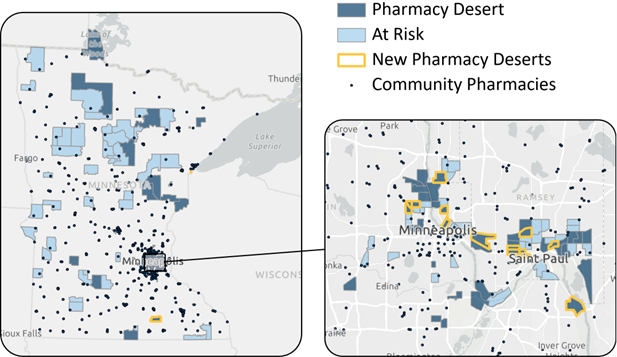Pharmacy Closures Are Impacting More Minnesotans
Minnesota data show that access to community pharmacies in Minnesota has decreased over the past decade.
Nearly half a million Minnesotans live in areas with low pharmacy access. Many more live in areas that are at risk of losing access with the closure of a single pharmacy.
Living farther from a pharmacy or drug store makes it more difficult to fill prescriptions, get education and recommendations on medications, and receive health care services.
The Minnesota Department of Health works with the University of Minnesota College of Pharmacy to address the issue of pharmacy gaps.
Pharmacies are vital to communities

Pharmacies are vital to patients and communities and a key part of the health care system, especially in rural areas.
These areas tend to be farther away from hospitals and clinics. A rural pharmacy could be the only readily available place a patient has to clinical advice and care.
While pharmacies are known as places where patients can receive immunizations and medications, they offer much more:
- Education on medication safety and use
- Medication therapy management (identifying and solving drug-related problems to improve health outcomes)
- Education on healthy lifestyle management
- Health screenings to support care
- Recommendations for health problems that can be managed with non-prescription care
- Identifying and referring patients who require a higher level of care for immediate or long-term health care needs
The lack of a nearby pharmacy can result in patients not receiving and taking their medication on time, which may worsen chronic conditions, increase hospitalizations, and result in poorer health.
“Not only is it a medication access problem, but pharmacists have historically been the most accessible health care professional,” said Dr. Anjoli Punjabi at the University of Minnesota College of Pharmacy. “They’re providing advice and guidance on preventative health and providing vaccines, point of care testing, medication management— many pharmacy services that would just be eliminated from these communities if these institutions close.”
Change in Number of Minnesota Community Pharmacies, 2009 to 2024

There were 136 fewer community pharmacies in Minnesota in 2024 compared to 2009. Most of the pharmacy closures have occurred in the last eight years, since 2017.
Changes in locations of pharmacies
Pharmacy deserts are communities where residents do not live close to a local pharmacy and also have additional barriers to access, like lower income or lack of transportation. Pharmacy deserts and at-risk communities with only one pharmacy remaining are prevalent in both rural Minnesota and the urban core of the Twin Cities.
Nearly 200,000 Minnesotans live in pharmacy deserts and 250,000 more live in at-risk areas. Pharmacy deserts and areas at risk of becoming pharmacy deserts are distributed across the state but are more concentrated in northern Minnesota and in areas north of I-94 in the Twin Cities.

Between 2009 and 2024, 16 census tracts with more than 50,000 residents have become new pharmacy deserts due to pharmacy closures. A majority of these are located in the Minneapolis-St. Paul urban core. Others are outside of Duluth and south of Owatonna in Southern Minnesota.
Communities that are geographically distant from pharmacies are classified as “low access.” Communities that are only served by a single pharmacy, leaving them at risk of losing access if that pharmacy were to close, are classified as “limited access.”
Some low access areas are in more affluent neighborhoods, where residents have the resources to access services despite living further away. This is why it is important to consider additional factors when classifying “pharmacy deserts” and targeting where support is needed to add or maintain pharmacy availability, said Emily Styles, an epidemiologist from MDH who works on the project.
The map of pharmacy deserts describes communities where farther pharmacy distance and these additional factors, including low income and lack of transportation, overlap.
In Minnesota, communities that have lost pharmacies since 2009 have been more socially vulnerable, meaning people living there experience a combination of factors that can negatively impact a community’s health, such as higher levels of poverty, poor housing conditions, and lack of access to transportation. In addition, these communities are frequently home to more Minnesotans who report a disability.
What is being done?
These maps were developed by the Minnesota Department of Health Cardiovascular Health Unit in collaboration with the University of Minnesota College of Pharmacy.
Policy change is needed to address pharmacy deserts. The Minnesota Pharmacy Alliance, which is composed of members representing Minnesota Pharmacists Association, Minnesota Society of Health System Pharmacists, and the UMN College of Pharmacy, has used these maps and data as evidence for policy changes with the Minnesota legislature.
The University of Minnesota also plans to work with pharmacists and community members to understand why pharmacies are closing and identify effective solutions.
For maps and more information on pharmacy deserts in Minnesota, visit:
It is support from the CDC’s Division for Heart Disease and Stroke Prevention and the National Center for Chronic Disease Prevention and Health Promotion that makes partnerships like these possible.
Definitions
Pharmacy Desert Areas are census tracts where the population center (the point in the census tract around which the population is equally distributed) is more than the below distance from the nearest pharmacy and meets the below criteria for income level and transportation access.
At-Risk Areas are census tracts being served by a single pharmacy and would become a pharmacy desert if this pharmacy closed.
| Area | Distance | Income Level | Transportation Access |
|---|
| Minneapolis/St. Paul urban core: Columbia Heights, Fort Snelling, Hilltop, Hopkins, Minneapolis, Richfield, Robbinsdale, South St. Paul, St. Louis Park, St. Paul, West St. Paul | 1 mile | 20% of its population is under 150% of the federal poverty line or the median income of the census tract less than 80% of the median income of the nearest MSA (Metropolitan Statistical Area) | More than 100 households or more than 10% of households without a vehicle available |
| Metro Areas: Outer Twin Cities metro, St. Cloud, Rochester, Duluth, Moorhead, Mankato | 5 miles | Meets the above income criteria | No transportation criteria |
| Non-Metro Areas | 15 miles | Meets the above income criteria | No transportation criteria |
This page was created in partnership with the University of Minnesota College of Pharmacy and references “Mapping pharmacy deserts across Minnesota,” published Dec. 17, 2024.